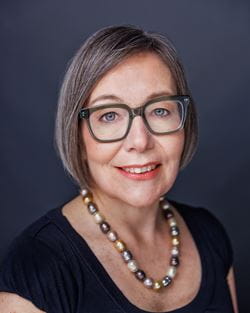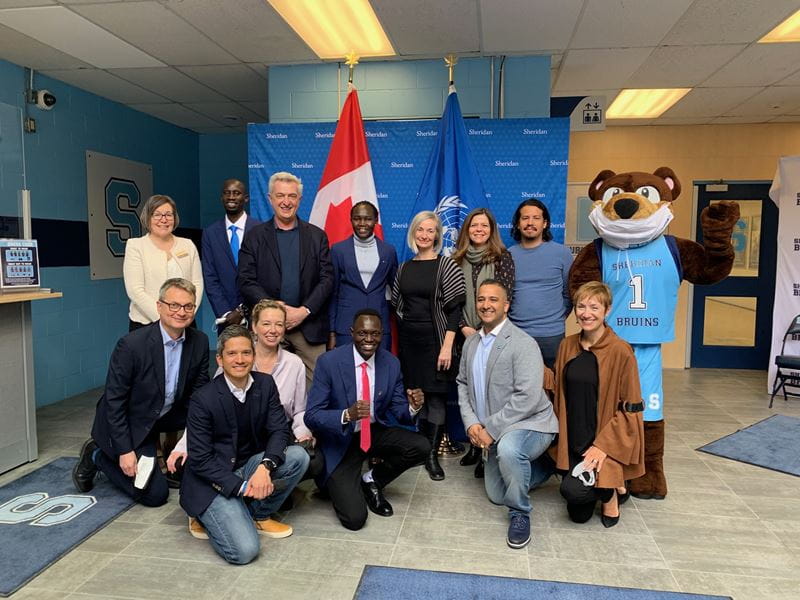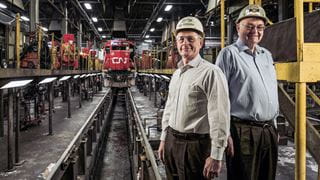
When the role of a lifetime comes knocking: An interview with Christine Szustaczek
 by Tara Sprigg – Apr 3, 2023
by Tara Sprigg – Apr 3, 2023 Organizations are said to be lucky if they find high-performing, emotionally committed employees to carry out their purpose. Luckier still is when they find employees whose personal values are directly aligned with the institution’s and who become an organization’s authentic ambassadors.
 Christine Szustaczek — Sheridan’s Vice President, External Relations — has been one of those employees. On the news of her upcoming transition to a leadership role at the University of Toronto later this spring, I had the chance to ask Christine a few questions about what makes Sheridan special, how communications contributes to the institution’s success, and what she’s excited about in post-secondary.
Christine Szustaczek — Sheridan’s Vice President, External Relations — has been one of those employees. On the news of her upcoming transition to a leadership role at the University of Toronto later this spring, I had the chance to ask Christine a few questions about what makes Sheridan special, how communications contributes to the institution’s success, and what she’s excited about in post-secondary.
You’ve spent 10 years of your career at Sheridan and have served in several different roles. What is it about Sheridan that inspired you over so many years?
Sheridan is such a special place. We’re big enough to be recognized as a pillar in our home communities and a leader to watch in our sector, yet small enough to be collegial, down-to-earth and familiar. Working at a mission-driven organization and being around so many other people who are passionate about their professions and who are committed to helping learners thrive creates an energy and vibrancy that’s palpable. Creativity really is in our DNA and it’s everywhere. I love that we view creativity as an idea engine and the precursor to innovation.
 I’m not sure if it’s because of the applied nature of our programming, but there’s a permission here to experiment and pilot new approaches. We’ve launched a Netflix reality TV show, helped to bring a Canadian musical to Broadway, developed first-in-Canada degrees that have pioneered entire new fields of practice, and created a money back guarantee during COVID that was unheard of in our sector. Working to shape Sheridan’s narrative has been a tremendous privilege. There has never been a shortage of good stories to tell — only a lack of time to get to them all.
I’m not sure if it’s because of the applied nature of our programming, but there’s a permission here to experiment and pilot new approaches. We’ve launched a Netflix reality TV show, helped to bring a Canadian musical to Broadway, developed first-in-Canada degrees that have pioneered entire new fields of practice, and created a money back guarantee during COVID that was unheard of in our sector. Working to shape Sheridan’s narrative has been a tremendous privilege. There has never been a shortage of good stories to tell — only a lack of time to get to them all.
The fact that we’re not afraid to profess our beliefs and drive systemic change is also inspiring. That is tough, courageous work and I am so proud to have played a tiny role in it. I’ve been extremely fortunate to have been trusted with increased scope and responsibility — first integrating the branding, marketing and communications teams, then joining the PVP table as Chief Communications Officer, and finally taking on the VP External Relations portfolio and bringing advancement, alumni relations, and government and community relations into the mix. I’ve always come into work feeling like there was something important to accomplish and that people were counting on me to contribute. My success is a function of the dedicated team of smart, forward-thinking, highly skilled professionals who I have the privilege of working with every day. They work tirelessly to capture, define and share Sheridan’s unique hallmarks and differentiators with the world and to cultivate connections with our communities. Their efforts communicate Sheridan’s character and build the trust and respect that generates goodwill and builds our reputation as a destination of choice for post-secondary education. What we do here is extremely motivating.
What was it that made you decide to look for other opportunities?
I honestly wasn’t looking to leave Sheridan when opportunity came knocking. Now I’m headed to the only role in Canada that could have lured me away.
I am very conscious that the work I’ve done here was foundational to getting me placed into U of T’s consideration set. I’m a firm believer that we are each the architect of our own future and that we can have it all — just not all at once. I’ve spent 30 years working in the public and non-profit sector including six years at the University of Toronto early on in my career. I began working in advancement and made the switch to public relations and strategic communications management which I really feel are my true calling. I am very deliberate about the roles I take on — volunteer or paid — and I know each one has something important to teach me. I really love learning. That’s why I can’t imagine working anywhere other than an educational institution. Being a part of the Sheridan community has been the privilege of a lifetime. It’s provided me with the confidence, experience, and desire to take what I’ve put in place here and apply it on a bigger stage.
During your tenure here, communications has evolved to become an essential management function that is deliberate, data-driven, and research-informed. Sheridan is now recognized as a leader in strategic communications in higher education. Can you talk about that evolution?
When I arrived at Sheridan ten years ago, we had a dedicated effort for marketing, branding, media relations and events. My initial position — Director of Corporate Communications and External Relations — was established to help Sheridan communicate with our internal and external audiences about Sheridan’s priorities. I firmly believe that communication isn’t about what an organization says, but rather what an audience hears and is inspired to think, feel, or do with that information. So rather than pushing out one-sided information, I’ve tried to embed a two-way dialogical approach to our communication campaigns so that we’re creating feedback loops to listen and learn from our audiences.
"Rather than pushing out one-sided information, I've tried to embed a two-way dialogical approach to our communication campaigns so that we're creating feedback loops to listen and learn from our audiences."
I embrace the definition of public relations as being the strategic management of relationships between an organization and its diverse publics, through the use of communications, to achieve mutual understanding, realize organizational goals and serve the public interest. That requires deep organizational listening and a constant scanning of the environment to know what matters to the people you serve. It’s a model that calls for bringing stakeholder interests and concerns to organizational decision-makers — where you have a seat at the table and have earned leadership’s trust — before operational decisions are made, and for bringing the organization’s purpose and rationale to your stakeholders. The outcome is a rich exchange of knowledge and ideas that results in mutual benefit for all parties. That’s the outcome of good PR. It’s not about generating publicity to gain short term, transactional attention. It’s about building understanding, acceptance, support, and harmony. It’s an approach that builds trust, respect and long-term relationships, which in turn inspire partnership and goodwill — all of which set an organization up for sustainable success. That’s the approach we’ve embedded into our work, which now includes internal, external, and executive communications, our owned media channels, media relations, issues management and social media.
 Everything we do is grounded in benchmarking research, baseline data and a commitment to measurement to see if we’ve enacted the change we were seeking. It’s also supported by proven theories and frameworks like relationship management theory, the situational theory of publics, excellence theory and self-determination theory to name only a few. As a result, our campaigns are built on something far deeper than a “gut feeling” that a recommended approach will work because it’s how we’ve done something before. They elevate our work to an applied social science and help breed confidence and respect for the role communications can play in enabling business objectives.
Everything we do is grounded in benchmarking research, baseline data and a commitment to measurement to see if we’ve enacted the change we were seeking. It’s also supported by proven theories and frameworks like relationship management theory, the situational theory of publics, excellence theory and self-determination theory to name only a few. As a result, our campaigns are built on something far deeper than a “gut feeling” that a recommended approach will work because it’s how we’ve done something before. They elevate our work to an applied social science and help breed confidence and respect for the role communications can play in enabling business objectives.
What would you say to employees who are just starting their journey at Sheridan? Is there a piece of advice you’d give to new Sheridan employees that you wish you’d had when you started?
Get involved. Attend Convocation. Offer to volunteer at student orientation. All of this is doubly true if you’re not in a student-facing role. Students are at the heart of everything we do. Seek out what matters to our learners and what we can all do to make their experience better. In your own practice, ask for feedback and opportunities to join larger projects that connect you to other areas. Seek out people in other departments for reciprocal, peer mentorship engagements. Our alumni draw on the deep connections and networks they formed during their studies to fuel their careers. There’s no reason why employees can’t do the same.
You’re moving on to another post-secondary institution. What excites you the most about post-secondary in Ontario right now?
Currently there’s a lot of public discourse that questions the need for formal post-secondary education and traditional credentials like certificates, diplomas, and degrees. Some people suggest that they’re no longer needed to enter or advance in the workforce, and that these changes will render them obsolete. I view higher education as timeless. That’s why I’m a staunch advocate for it.
Pedagogy and programs will always evolve to maintain relevance. But on an even more fundamental level, at its core, post-secondary institutions engage people in critical thinking and foster important discussion and debate — something that’s incredibly important at a time when the narratives that flood social and digital media channels are rife with half-truths and aim to deceive and polarize.
Post-secondary institutions are also incubators for new knowledge, and are where discoveries that address complex societal issues and lead to improved quality of life are made. Post-secondary programs put people on an upward trajectory to social and economic gain, enabling them to be meaningfully employed in their chosen fields and to contribute to a community’s well-being. I am the first generation in my family to attend post-secondary studies. It has opened up possibilities for me that were out of reach for my parents. What excites me most about post-secondary in Ontario right now is that it remains our very best hope for a bright, successful and civil future.
(This interview has been edited for clarity and length.)
In banner photo, Sheridan VP, External Relations Christine Szustaczek (left) stands with organizers of last year's Improving the International Student Experience Summit at Davis Campus. In second photo, Christine is pictured with Olympic champion sprinter — and former Sheridan student — Donovan Bailey during the filming of Sheridan's 2021 virtual Spirit Day event. In third photo, Christine and other Sheridan executives and administrators are joined by Filippo Grandi, United Nations High Commissioner for Refugees, celebrating a new athlete pathway pilot program that enabled three refugee athletes to be offered a post-secondary scholarship to live, study and train at Sheridan.
Media Contact
For media inquiries, contact Sheridan’s Communications and Public Relations team.



